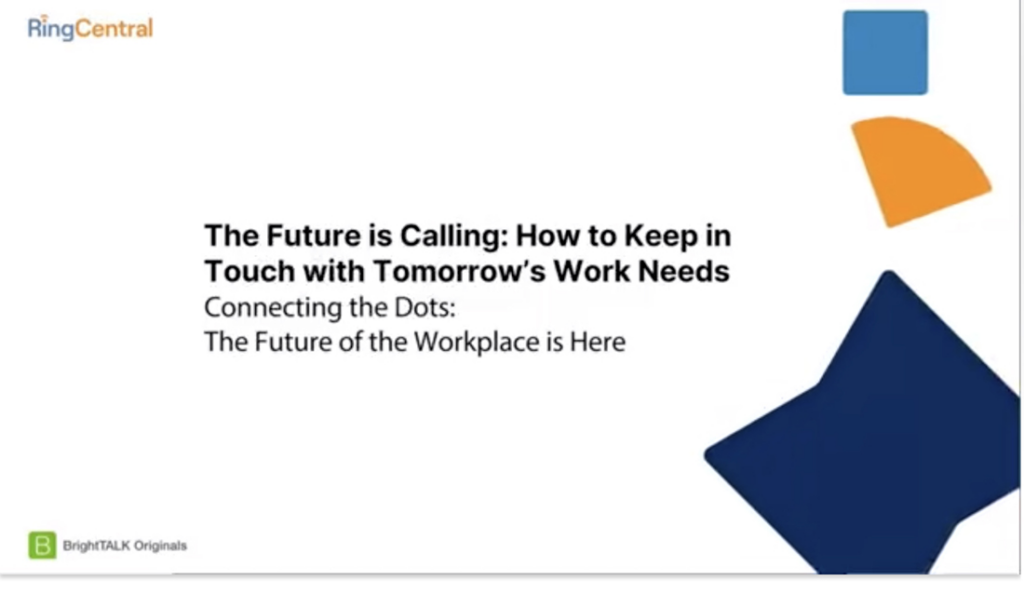
It’s relatively easy to launch a new communication, collaboration or contact center application. But it’s much more challenging to integrate it with your existing technology stack and user workflows. That’s why you need to take a thoughtful approach and gather lots of feedback from your users on how to make their lives easier.
“Building real human connection within your company requires more than the ability to send a message,” said Andrew Spence, Glass Bead Consulting in the UK. “Many users are being tripped up by multiple products and platforms and think a single communications hub would be ideal.”
Spence moderated a recent BrightTalk panel discussion, “Connecting the Dots: The Future of the Workplace is Here,” sponsored by RingCentral. Panelists were Andrew Deutscher, founder, Regenerate; and Esther Yoon, AVP of product marketing, UC, Ring Central.
Spence kicked off the conversation by noting that the pandemic led many companies to rapidly adopt new technology and communications channels, but these selections were often made blindly. “Now, we need to move to a proactive mode and connect the dots of static and siloed technologies,” Deutscher said.
Yoon added that IT leaders will also need to manage more variables moving forward. That’s because some workers will be permanently remote, others may come into a physical location several days a week, while others may be there full time.
“You need to be deliberate when looking at workplace connectivity, as there is no one-size-fits-all solution,” added Yoon. “Look at how work is being done in your organization, rather than simply the location. For instance, you might want everyone to come into the office for intentional bonding and gathering, or to advance an important mission or project.”
The art of communication
When it comes to collaboration, pay attention to the channel as well as the message, said Spence. After all, voice, text, email, chat and team apps are appropriate for different situations. Text and chat, for instance, are more casual, while email may be more suited for sending formal documents or messages. Most large organizations have CRMs, sales or project management applications that also serve as communication channels.
“Everyone has different communication preferences, just like personalities,” added Spence. Of course, there is also a great deal of variation in the employee experience, such as knowledge workers, frontline staff, and contact center agents.
“When onboarding new people, you should include information on messaging,” said Yoon. “They need to understand how to communicate with team members, customers and managers. You could also provide them with best practices on how to be better communicators.”
Best practices
While virtually all organizations are struggling with improving the effectiveness of communication technology, there are some best practices, according to Yoon. “You want to think about how to approach communications in the most human way,” she said. Suggestions from Yoon and Deutscher include:
• Focus on asynchronous messaging, such as email, when dealing with colleagues across multiple time zones. “That’s one way to stay caught up with what’s going on without being overwhelmed by tons of meeting recordings,” Yoon said.
• Use analytics to see which tools are being used within the organization and how those patterns may differ by departments or teams.
• Collaborate with human resources (HR) through tools such as user surveys or focus groups. “You need to get feedback on what’s working and what’s not,” Yoon said.
• Be patient. “Owners, employees and executives need to realize that change initiatives require a degree of patience,” Deutscher said. “It takes time to get used to new work flows and move the needle on productivity.”
• Be sure that users receive and understand your messages. “Just because you shout it out doesn’t mean it landed,” said Yoon. For instance, a user might miss a time-critical message posted a noisy chat channel. Instead, it might be better to email the message and call or text the recipient to provide a heads up.
• Look for ways to integrate your communication technology stack or find new tools that mesh with your key applications. “Think interoperability and how to reduce the time wasted switching between apps,” said Yoon. “You also want to provide broad access to applications for your cross-functional use cases.”
Finally, Spence noted the importance of looking for ways to add value. “Simplify and focus on what’s meaningful to your organization,” he said. “Be sensitive to employees who may be reluctant or fearful of change, and let them know you are giving them tools they need to succeed.”
